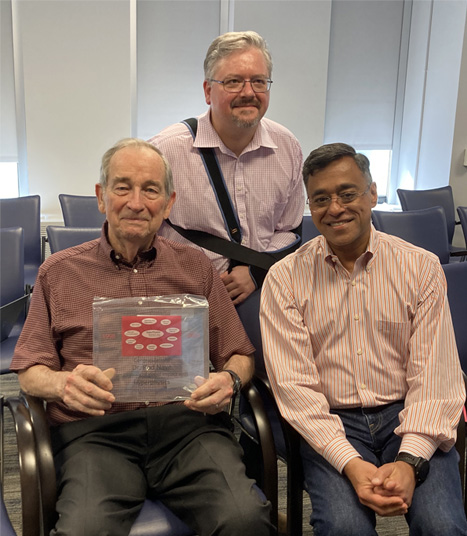Celebration of HyperPhysics at Georgia State University
April 4, 2023
The publication of the review article about the 25th anniversary of HyperPhysics in Physics Today generated a lot of attention to HyperPhysics on the Georgia State University campus. The HyperPhysics Committee, chaired by Deepak Raghavan, began planning a special recognition of HyperPhysics in the Department of Physics and Astronomy. It was decided to do a brief recognition of HyperPhysics at the beginning of the William H. Nelson Lecture on April 4.
I then received an email from Varun Chaturmutha, a graduate student in the Department, proposing a video interview with Brenda and I about the development of HyperPhysics. He is part of an effort to produce a series of video podcasts for the Department of Physics and Astronomy, mostly to highlight the research efforts, as I understand it. This series is to be called the PandA Podcasts, the PandA being a play on Physics and Astronomy. He proposed to make the discussion of the development of HyperPhysics the inaugural podcast in the series.
That inaugural podcast on HyperPhysics features Varun and Rod and Brenda Nave.
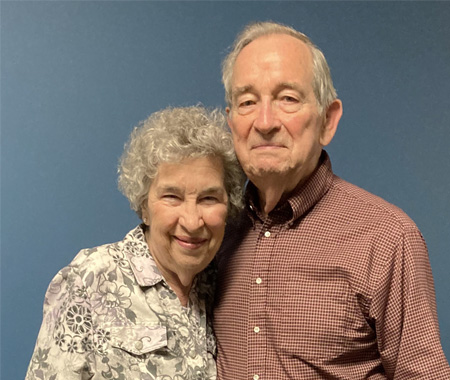 | Brenda and I went to Georgia State on April 4 and met Varun and two other graduate students in a video recording room in the GSU Library. I had given him the link to the Hyperphysics presentation I had made at a meeting of SESAPS at Georgia State in 2015 for ideas about what to discuss, and he reviewed material in our photo album to come up with an agenda for the recording session. A 2016 review of the process when we transferred HyperPhysics to a GSU server also served to guide the agenda. Varun seated Brenda and I on one side of a table with earphones and he sat on the other side, similarly equipped. His two colleagues managed the electronics. The following is a brief outline of the topics in the Podcast discussion. |
HyperPhysics, the PandA Podcast
- HyperPhysics was placed on the web in 1998 as an html framework accessible by a web browser. Prior to that, starting about 1990, it was developed in the HyperCard software by Bill Atkinson.
- The HyperPhysics title came from the idea of hypertext, active text in documents which could be clicked to go to another location in the document. HyperPhysics was a framework navigated by hypertext, but also by clicking on locations on active graphics, enabling the document to be navigated from either active text or graphics, ideas developed by Atkinson.
- Recognizing the danger of developing instructional projects on proprietary software which could disappear, a group of us at an AAPT meeting in Denver in 1997 discussed strategies to protect our software developments. Our conclusion was that the language of the web, html, was a much safer development tool than any proprietary software package since the web, online in 1992, used html as its basic language and as such would be likely stable as a development pathway.
- This decision brought me to the first major fortuitous circumstance that led to the rapid development of HyperPhysics on the web. Atkinson had not only made active graphics for document navigation part of HyperCard, he had also developed HyperTalk, a mathematics framework for doing calculations. My development of calculations in HyperTalk proved to be relatively easy to convert to Javascript routines to put the calculations into to web version of HyperPhysics. All this was very fortunate for HyperPhysics; its use expanded rapidly on the web as html with Javascript, while Atkinson's HyperCard bit the dust in 2004.
- For the question about what inspired the development of HyperPhysics, I had to point primarily to the Conceptual Physics course. In 1980 I was commissioned by Dr Joe Hadley to develop a physics course appropriate for the needs of students in the College of Education who were seeking a degree in Science Education. I developed a six week pair of intensive courses for the summer term which quickly became very popular. By the 1990s it was commended by the College of Education as their favorite of our course offerings for them.
- The need for something like HyperPhyics became evident quickly in the experience of the Conceptual Physics courses. In its first few years we got many reports about students who started their teaching careers in a high school or middle school and were found to be the best prepared in physics. They were promptly handed the duty of teaching the physics courses.
- For me, this made it evident that these teachers needed further help, and the idea of development of an online support framework was born. It was also the time of the birth of the Internet in 1992 and the introduction of graphic interfaces for computers, so the tools for development of such a support framework were coming into place.
- Brenda was asked her perspective about the development of HyperPhysics when it was underway. She used the analogy of painting a battleship - you start at the stern, paint forward to the bow, then return to the stern and start over with the painting. It did continue in its development to broaden its subject matter.
- Asked how HyperPhysics had affected my teaching and that of others, I pointed to the practice of projecting HyperPhysics in the classroom with its graphic interface and facilitating discussion by navigating through the subject matter. A course outline could be projected and links followed to any part of the course.
- Responding to the nature of communications I had received about HyperPhysics, I had to share my amazement at the number and helpfulness of communication from around the world. As an example, I used the discussion of sun dogs, the multicolored light spots on each side of the Sun when ice crystals are present. I had started with the presumption that they would be only in cold climates, but was dramatically proven to be wrong from communications from around the world. I even received evidence of sun dogs within a few degrees of the equator!
- What were some of the memorable communications from users?
- I had emails from some engineering students in India who wanted to use HyperPhysics resident on their laptops to carry to rural areas to teach students. I sent dvds of HyperPhysics so they could mount it on their laptops and not need internet access to use it for teaching.
- In the early years of HyperPhysics it was served from my office computer at Georgia State, which could be taken down by many types of events. One Saturday morning I received an email from a 10 yr old girl in New Zealand, fussing at me because she couldn't get onto HyperPhysics and she had been using it to prepare a school assignment for Monday! I drove in to Georgia State to reboot my office computer and emailed her back to tell her it was available.
- At the time of the Rwanda genocide, I received an email from the University of Rwanda requesting a copy of HyperPhysics to use in teaching since their library had been burned down in the violence. I sent a copy by dvd with permission to mount it on their university computer.
- Particularly in the first few years, there were many areas of the world with no convenient internet access. HyperPhysics has been sent to 89 countries to date on DVD or USB media.
- A full translation of HyperPhysics into Spanish has been accomplished by Manuel Olmo of Seville, Spain. Copies of HyperPhysics have been supplied to persons who sought to translate into about 15 languages, but those have not yet been placed on the web.
- Our most recent picture of the use of HyperPhysics was provided by Justin Cantrell. In March 2023 he found that in about a month the number of unique IP addresses accessing HyperPhysics was about 1.5 million from 234 countries! Since the United Nations lists only 195 countries, there are some questions about what subdivisions of countries are included. But the results suggest a unique user for every 1.7 seconds!
- Plans for the future of HyperPhysics include the formation of the HyperPhysics Committee at Georgia State, chaired by Deepak Raghavan, to provide assurance of its continued availability through GSU.
Thanks to Varun Chaturmutha for arranging the recording session. He shared that he had discovered HyperPhysics in about 2014. He has been in the GSU graduate program for three years now, and he said that he did not know that HyperPhysics was associated with GSU until after his arrival. I shared with him my story of meeting Zaheer Ahmad for the first time when I walked into the Physics 2030 laboratory of which he was laboratory instructor. When I introduced myself to him, he came over and hugged me, and then pulled out his phone to take a selfie of himself and me. He sent it to his partner in Pakistan with whom he had spent five years teaching MCAT preparation courses in Pakistan using HyperPhysics as their reference! (MCAT = Medical College Admission Test for applicants to Medical School)
After finishing the recording session, Brenda and I proceeded to the 25 Park Place building to the auditorium where the William H. Nelson lecture was scheduled. The HyperPhysics celebration was scheduled as the first 15 minutes of the gathering there. Ben McGimsey presented a brief discussion of HyperPhysics and described how he was using it as the textbook for the Physics of Music and Speech course, Physics 2030. I invited him to take over the teaching of that course when I ended my involvement in active course teaching in about 2018. I have been pleased that he has enjoyed the teaching of that course, as I did. I taught it for about 45 years.
Deepak Raghavan also made some comments about HyperPhysics and the plans of the HyperPhysics Committee to assure its continuation. He also shared part of an email from a lady in Pakistan which I had copied to him.
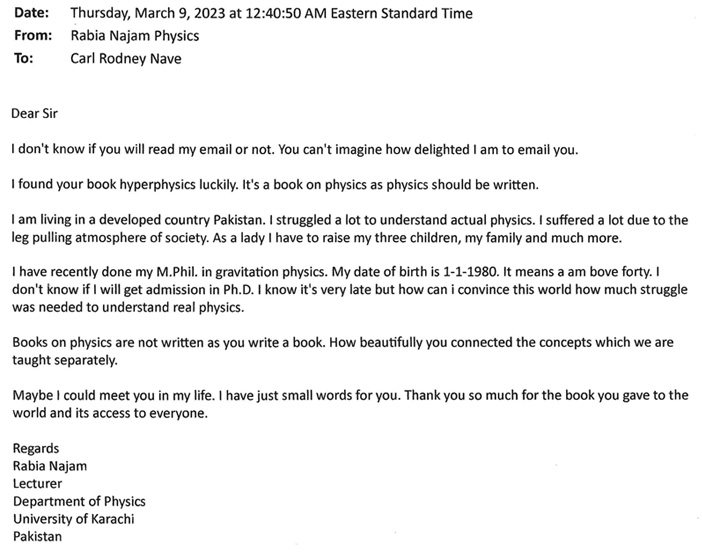 | This email had an impact on both Deepak and myself, coming from a woman in a country which she recognizes as "developed", yet having had a struggle to get the education she desired. Pakistan and India have much more tolerance for education for women than many other countries in the region. |
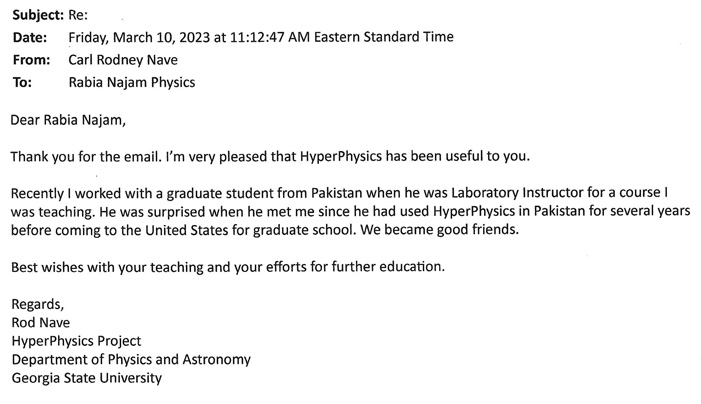 | The sentence "Thank you so much for the book you gave to th eworld and its access to everyone." certainly heightened my awareness to the value of the fact that we have distributed HyperPhysics freely, worldwide, and with no barriers, no ads, no pop-ups. |
Our early decisions for free distribution on the web and free, unfettered access seem much more important now that I am aware of how thoroughly it has blanketed the Earth and its penetration into so many areas which have major barriers to education, particularly for women.
The Chair of Physics and Astronomy, Dr. Sebastien Lepine, also had a contribution to the celebration. He announced a new achievement award for outstanding graduate students, to be called the Rod Nave Educator Award. Sebastien also presented to Rod a very nice plaque in celebration of HyperPhysics and its educational impact. Picture here are Sebastien Lepine in back with Rod and Deepak Raghavan in front. Rod is holding the plaque which had been presented to him. |
|
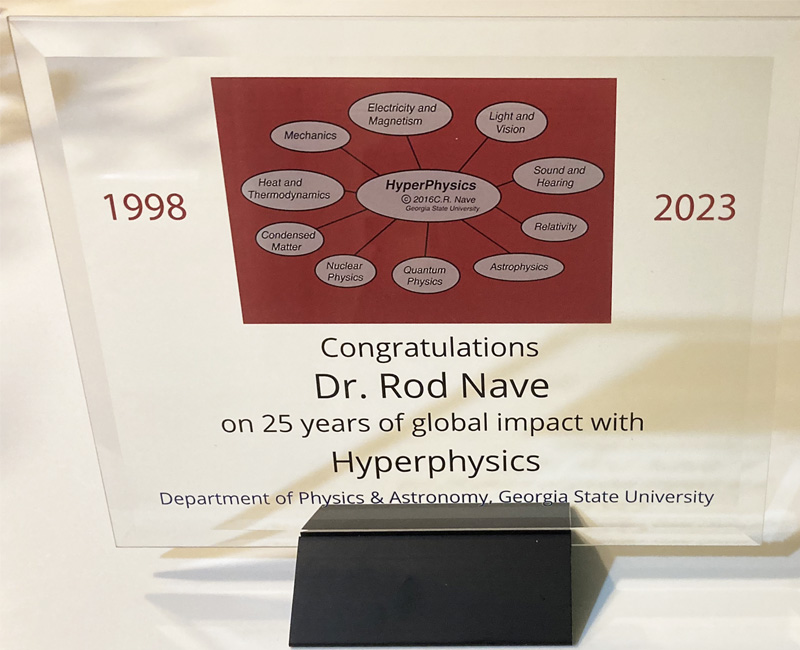
| Supper for BCM at Georgia State University |
2023
